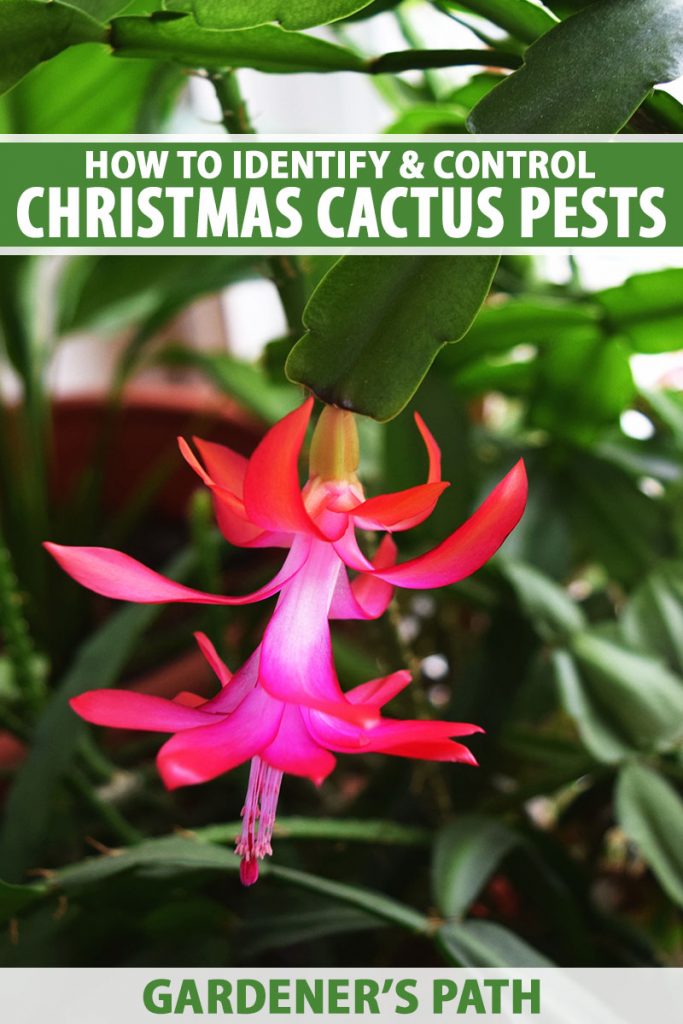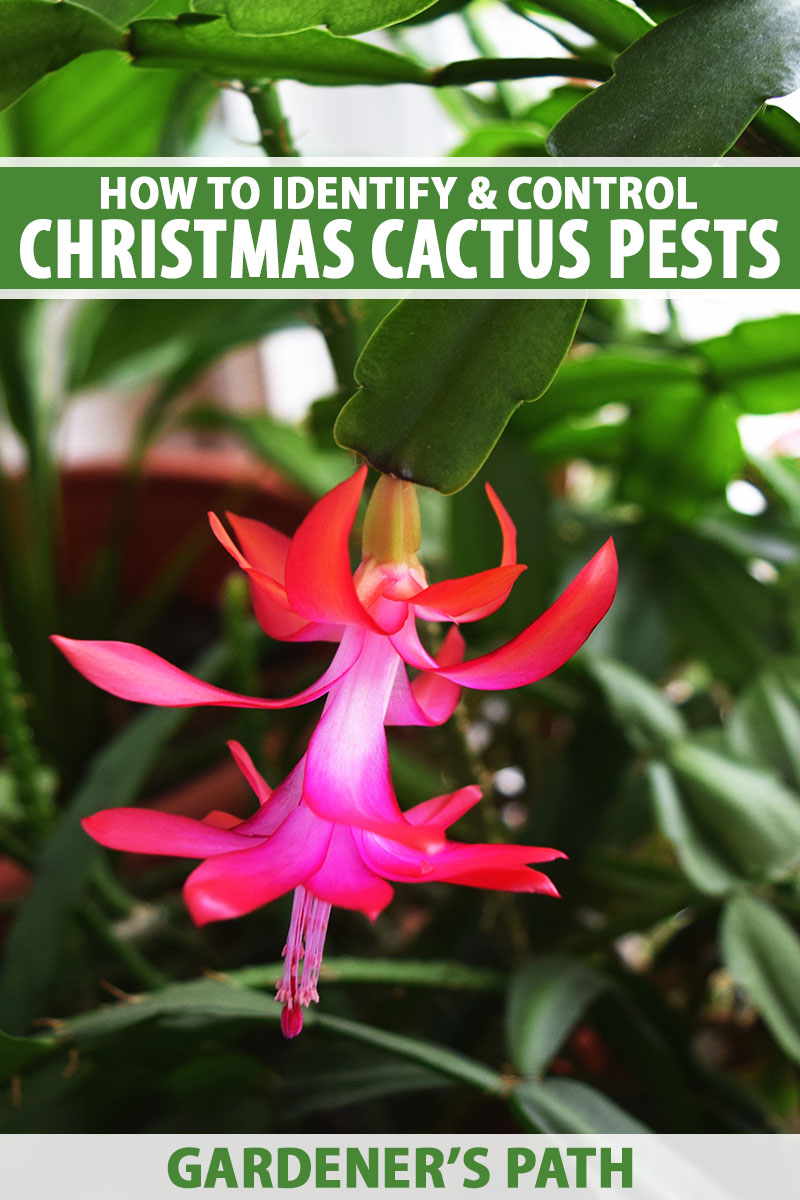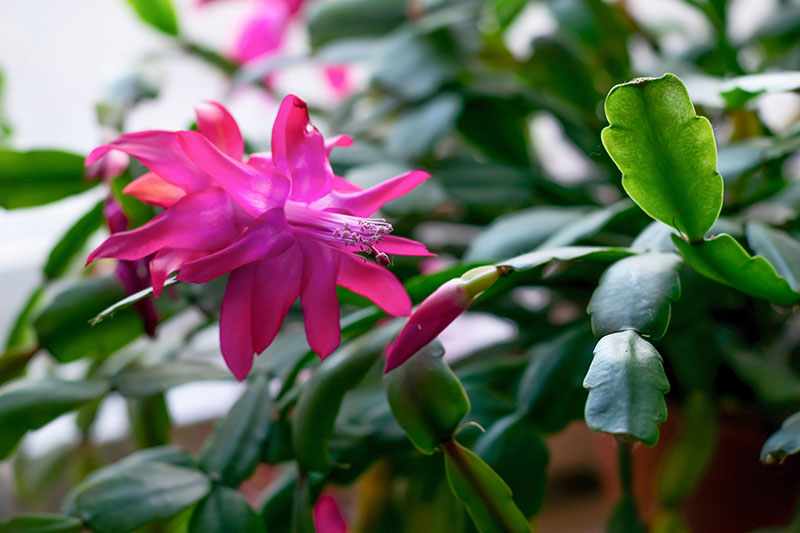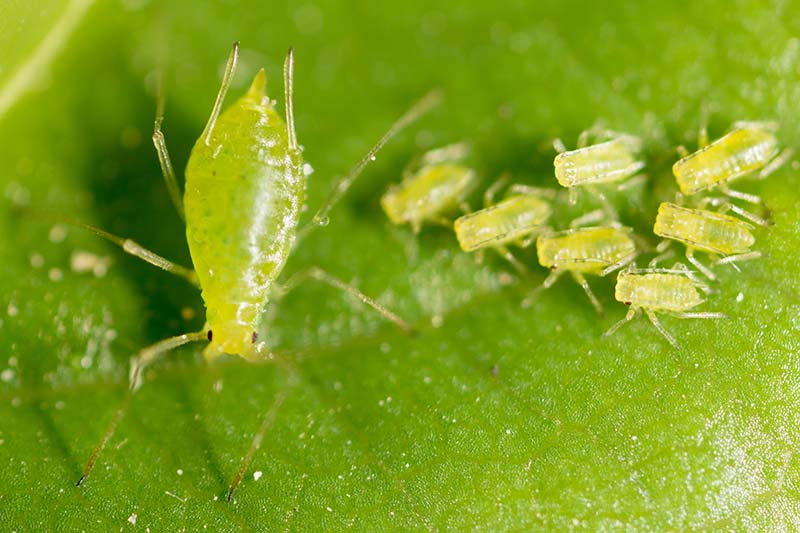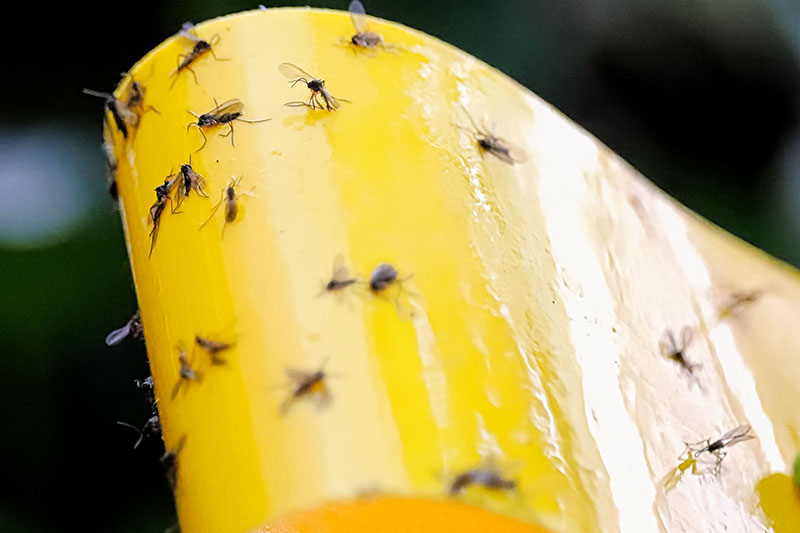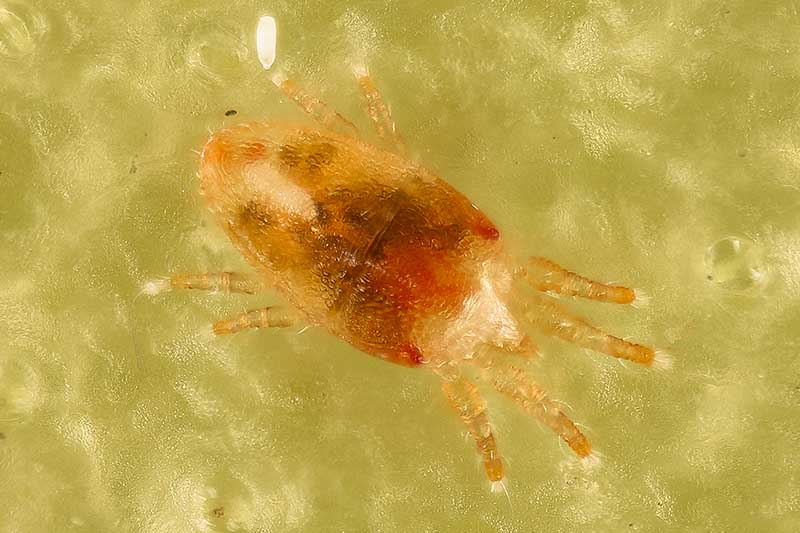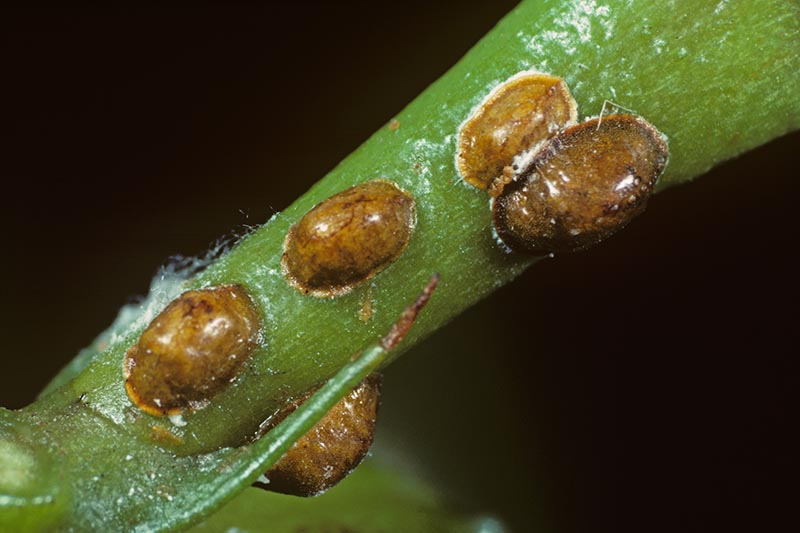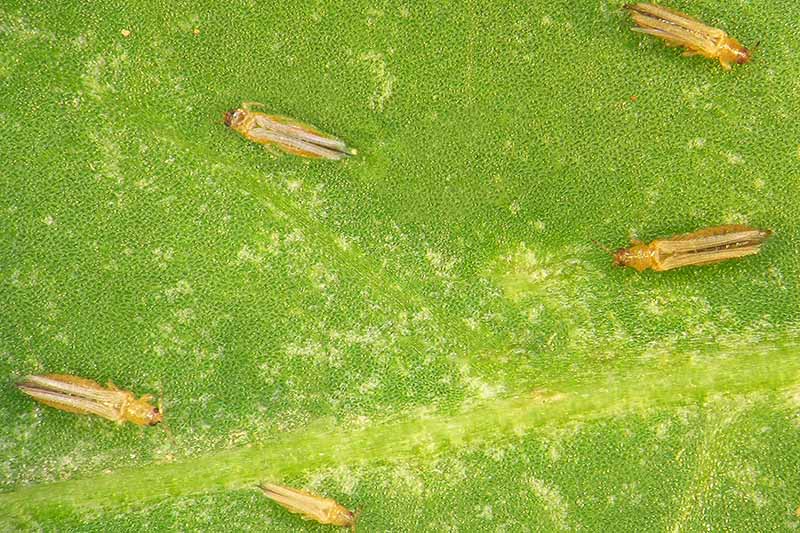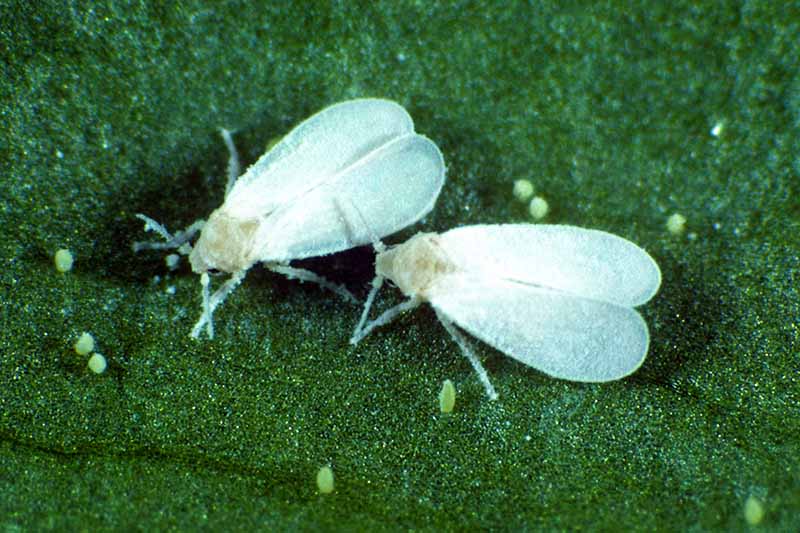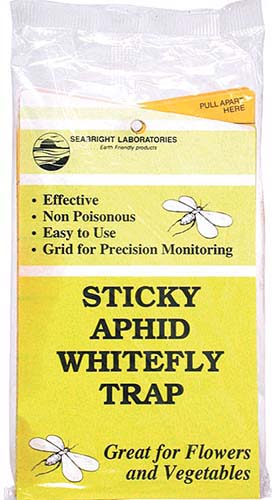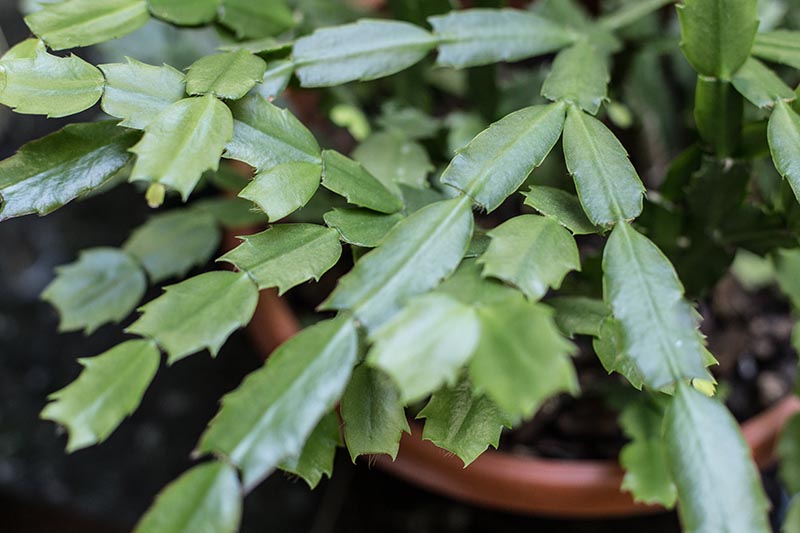As houseplants, they are easy to care for, and can be manipulated to bloom each year at a particular time, for many enjoyable holiday seasons. Our guide to growing Christmas cactus broadly discusses all you need to know for successful cultivation. We link to vendors to help you find relevant products. If you buy from one of our links, we may earn a commission. Here’s the lineup: Insects target foliage to satisfy their needs for nourishment and shelter. Let’s find out which ones may spell trouble for your plant.
7 Common Christmas Cactus Pests
A healthy cactus is the least susceptible to pests. When you provide a location with indirect sunlight, a pot full of organically rich, well-draining potting medium, and water only when the top one to two inches of the soil feel dry, your troubles should be few.
However, bugs are prone to turning up nonetheless. Sometimes, even with the best care, a poor-quality potting medium harbors insect larvae. Or pests may hitch a ride indoors on people and pets, plants that summered outdoors, or a breeze passing through an open door or window. Let’s meet seven common pests. They are not harmful to humans, but all may destroy foliage in the event of a severe, unchecked infestation.
1. Aphids
Aphids, Aphidoidea spp., are soft-bodied, sap-sucking bugs that come in from outside. There are numerous species in an array of colors including yellow, green, pink, black, and brown.
They like a great deal of juicy foliage to chew, so cacti that are comfortably moist and well-nourished are prime targets, making this pest hard to avoid. Live-borne nymphs, and both winged and non-winged adults, feed on foliar tissue, causing yellowing and deformity. Sticky excretions called honeydew inhibit photosynthesis, and create a breeding ground for a number of fungal diseases referred to collectively as sooty mold. There are a variety of ways to manage aphids. First, take the cactus to the kitchen sink and rinse it with a steady stream of water from the spray nozzle. Wash as many aphids as you can down the drain. Place a sticky trap near the pot, and/or a bowl of soapsuds made with one or two drops of dish detergent per two cups of water, to attract and catch flying aphids. For persistent pests, spray the foliage with horticultural neem oil per package instructions. This is an organic insecticide, fungicide, and bactericide derived from evergreen neem seeds. Alternatively, you may use neem oil to drench the soil. This is called a systemic approach, in which the roots take the oil up into the foliage, where the aphids consume it and die off. You may also spray the foliage with a houseplant product that contains pyrethrins, an insecticide derived from chrysanthemums. There are also chemical pesticides, such as imidacloprid, available for systemic use. Personally, I’d rather throw away the cactus than mess with chemicals, however, as long as you use a product specifically formulated for indoor use, you can avoid the toxicity of the highly concentrated products used on outdoor crops.
2. Fungus Gnats
Fungus gnats, Lycoriella spp., live in soil and other types of potting medium that are rich with damp, decaying organic matter. Sometimes they are present at the time of potting. Newly hatched larvae feed on roots, and can cause stunting and wilting. Adults flit about like fruit flies, sending you looking for a rotten banana. They are short-lived, eat very little, and do no harm, but they create a nuisance and always seem to be in your face. A close look at an affected plant may reveal slimy evidence of larvae having crawled over the top of the potting medium, and tiny gray-black flies hovering over and around the pot and near sources of light. In addition, the stem segments may begin to yellow. With proper drainage, the avoidance of overwatering, and the use of quality potting medium, outbreaks may be avoided. The use of sticky traps can help with annoying adult flies. Commercial remedies are targeted at the eggs, larvae, and pupae in the potting medium. Beneficial nematodes, soil-borne roundworms that feed on fungus gnats, are a safe treatment. Another is food-grade diatomaceous earth, a silica powder derived from the fossils of single-celled algae called diatoms. It is impossible for fungus gnat larvae to crawl through this powder without injury. Unearth your cactus and rinse it, roots and all. Wash the flower pot, and replant in fresh potting medium with the addition of either beneficial nematodes or food-grade diatomaceous earth for best results. Read more about controlling fungus gnats here.
3. Mealybugs
Mealybugs, Pseudococcidae spp., travel easily from plant to plant, especially when they are placed in close proximity to one another, and there is an excess of available moisture. Some types suck the sap from foliar tissue above the soil, while others prefer the roots. They have a white, fuzzy appearance, and lay eggs in a mass that looks like cotton fluff. Fans of tight spots, they are often visible in the joints of stem segments and intersections of tangled roots. An unchecked infestation may lead to yellowing and wilting of foliage, and/or root destruction. To address an outbreak, place your cactus in the kitchen sink and rinse off as many mealybugs as you can with the sprayer. For those that remain, you may try wiping them off with a rubbing alcohol-saturated cotton ball. Use caution, because rubbing too hard breaks tissue cells. Rinse afterward. You may spray neem oil or pyrethrins to address a stubborn infestation of the green stem segments. If the roots are affected, you can do a neem oil or pyrethrin soil drench to kill bugs both below the soil and above. And finally, you may use a chemical imidacloprid treatment at the soil level, as well. If an infestation has damaged the roots beyond treatment, you may be able to find several unaffected stem segments to propagate. Mealybugs can be hard to get rid of. Treat all plants in proximity to the infested one, allow for ample air circulation to limit further spread and transfer, and don’t overwater. Find more information on controlling mealybugs here.
4. Red Spider Mites
Red spider mites, Tetranychus urticae, often arrive indoors on the backs of pets, shoes of people, or leaves of houseplants that have spent time outdoors. Technically arachnids rather than insects, red spider mites are web-spinning, eight-legged bugs that look like tiny reddish-orange walking dots. When they colonize, they appear as a mass of discoloration on the green stem segments of a Christmas cactus. These sap-suckers prefer dry and dusty places, and do their worst damage to water-stressed foliage. Vulnerable flora may quickly succumb to yellowing and wilting. To rid a cactus of this pest, place it in the kitchen sink and use the spray nozzle to dislodge as many mites as possible. Follow up with an application of neem oil, and be sure to treat all plants in close proximity. Foliar applications of products that contain pyrethrins are effective against some species of mites, but not necessarily against this one. Periodically rinse plants, or wipe them gently with a damp cloth, to avoid dust buildup, and remember to water when the first one to two inches of potting medium are dry to the touch. Read more about combating spider mite infestations.
5. Soft Brown Scale
Soft brown scale insects, Coccus hesperidum, look like flattened, yellowish to brownish scabs. They progress from immobile nymphs to crawlers, but seldom to flying insects. These pests favor indoor climates that are especially warm and dry. They suck sap and leave a trail of honeydew that invites sooty mildew, potentially causing wilting and the inability to absorb sunlight for photosynthesis. At the first sign of sticky stem segments and brownish spots, try using your fingernail to gently dislodge the scale, or use a cotton swab saturated with rubbing alcohol. Be gentle, and rinse afterward. As the influx progresses, there may be leaf yellowing. To treat an advanced infestation, spray the foliage with neem oil or a pyrethrin-containing product. Repeat foliar applications as needed. Systemic soil-level application may be required as well, to rid your plant of this pest. Treat all houseplants in the area to prevent the spread of this pest. Find more tips on combating scale infestations here.
6. Thrips
Some types of thrips, Thysanoptera spp., are considered beneficial insects since they like to feed on other kinds of bugs in the garden. Others feed on plants and cause foliar damage, resulting in deformity as well as yellow, papery, or silvery tissue. And some species feed on pollen and damage flowers. Thrips may come indoors on plants that have summered outside, or on any vegetation that enters your home. In other words, they may be present from day one, waiting to emerge.
Thrips are more likely to infest foliage that is too dry. As they evolve from the egg stage to mature, winged adults, their colors range from pale and yellowish to dark brown or black, although there are exceptions. You may also observe frass, tiny black dots of insect excrement. If you see these on your Christmas cactus, use the sprayer attachment on your kitchen sink to remove as many as you can. Apply neem oil or a pyrethrin-containing product to the foliage, or to the soil for a systemic treatment. Read more about identifying and controlling thrips here.
7. Whiteflies
Whiteflies, Aleyrodidae spp., are tiny flies that feed on plant juices, and may first be noticed in the crook of a segmented stem. When disturbed, they lift off into a little cloud of powdery white. As adults and newly-hatched nymphs feed, they inhibit growth, and excrete honeydew that predisposes tissue to sooty mold. As they go along, the stem segments may turn yellow and begin to die off. Give your cactus a bath in the sink with the sprayer, and then set a yellow sticky trap or two nearby, and maybe a sudsy bowl of one to two drops of dish detergent mixed with two cups of water. With several foliar applications of neem oil or pyrethrin, you should be able to rid your Christmas cactus of this pest, especially if you treat neighboring plants as well. For stubborn infestations, you may need to apply a product systemically at the soil level. Read more about controlling whiteflies here.
Where to Buy Pest Management Products
First, a note of caution: When purchasing products to manage the seven common pests described, choose only those intended for use indoors. Consider children and pets when opting for non-organic chemical treatments. When possible, treat plants outdoors in seasonal weather, and allow them to dry thoroughly before returning them to the house. Foliar sprays may require repeated applications. Here are some useful products to consider: To catch flying sap-suckers, you may want to place a few sticky traps near an affected plant.
Yellow Sticky Traps Find aphid/whitefly yellow sticky traps from Arbico Organics in packages of five. For fungus gnat larvae, an application of food grade diatomaceous earth may be all you need. You can also use it at repotting time as a preventative measure. Food Grade Diatomaceous Earth Another option for sap-sucking bugs is a foliar spray of a pyrethrin-containing product that may also be used as a soil drench. Houseplant & Garden Insect Killer It’s an organic product that comes in a ready-to-use 24-ounce bottle in packages of one or four. To treat persistent sap-suckers, you may try horticultural oil as a foliar spray or soil drench. Bonide Neem Oil And finally, for severe sap-sucking pest outbreaks, you may want to try a houseplant product that contains the chemical pesticide imidacloprid in a formula that is suited to indoor systemic use at the soil level. Systemic Houseplant Insect Control Choose one, two, or four packages per order.
Don’t Bug Me
Recognition and management are essential, as common Christmas cactus pests like aphids, fungus gnats, mealybugs, red spider mites, soft brown scale, thrips, and whiteflies can cause problems ranging from stunted growth, yellowing foliage, and wilting, to root damage and vulnerability to diseases like sooty mold.
In addition, when a plant is infested, it may harbor sweet trails of excrement that attract even more pests, like ants. Insects may also be vectors, or carriers, of diseases that may affect your cactus or other plants in your home. If you give your houseplants a vacation outdoors, be sure to inspect them for pests, and apply neem oil to the foliage before bringing them in for the winter. With quality potting medium, indirect sunlight, and the avoidance of overcrowding and oversaturation, a Christmas cactus makes a relatively trouble-free houseplant for years to come. If you are interested in learning more about Christmas cactus care, you’ll want to read these guides next:
What Is the Best Potting Mix for Christmas Cactus? How to Make a Christmas Cactus Bloom Understanding Hair-Like Roots on Christmas Cactus
© Ask the Experts, LLC. ALL RIGHTS RESERVED. See our TOS for more details. Product photos via Arbico Organics, Bonide, Garden Safe, and Harris. Uncredited photos: Shutterstock.
